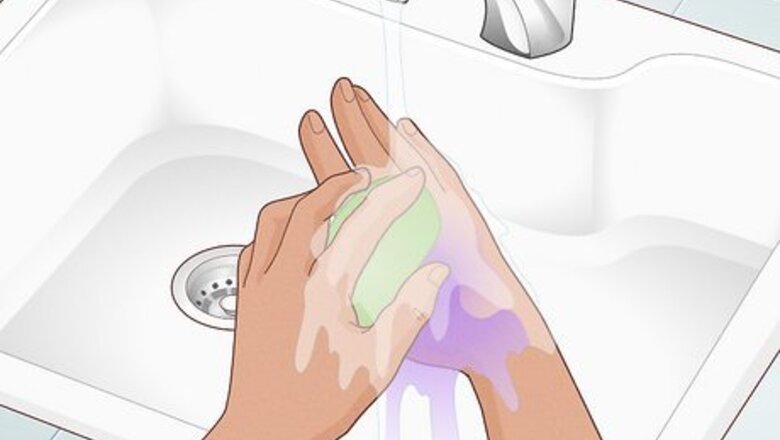
views
- Use acetone and alcohol-based products to remove spray paint from surfaces like skin, fabric, and glass.
- Use paint thinner or paint stripper on surfaces like brick or concrete to remove spray paint.
- For large, outdoor areas, powerwash surfaces to remove spray paint.
Removing Spray Paint from Skin

Wash your skin with soap and warm water. If the spray paint is still fresh, you might be able to remove it by scrubbing vigorously. To remove spray paint from skin in hard-to-reach areas, like your legs or feet, use a washcloth.

Apply vegetable oil, baby oil, or cooking spray to your skin. First, soak a cotton ball in the oil of your choice. Then, use the cotton ball to liberally dab your skin with the oil. For tough areas, use a rag, a fingernail brush, or a toothbrush. Rinse with soap and warm water to remove any remaining residue. If you use cooking spray, spray it directly onto your skin rather than on a cotton ball.

Use a pumice soap for pesky patches. If oil didn’t remove all of the spray paint, try a pumice liquid soap, pumice bar soap, or pumice bar. Any method of using pumice should work, but be cautious with pumice if you have sensitive skin. Pumice bars are often used to clean feet. Purchase pumice products at your local convenience or drug store.

Apply white vinegar if nothing else works. If all else fails, soak a corner of a rag in white vinegar and dab it on your skin. Then use a brush to scrub off the paint. White vinegar can be harsh on the skin and cause irritation, so use it with caution. Always wash your hands with soap and water and apply a moisturizer afterward.
Removing Spray Paint from Fabric

Rinse the fabric with water. It’s easier to remove spray paint from fabric if you can treat it while it’s still wet. Hold the fabric under cold water until it runs clear, or if you’re dealing with carpet or upholstery, blot the affected area with a cold, damp cloth or towel. If you’ve simply dusted the fabric with spray paint or if the paint has dried, you can skip this step and start cleaning it.
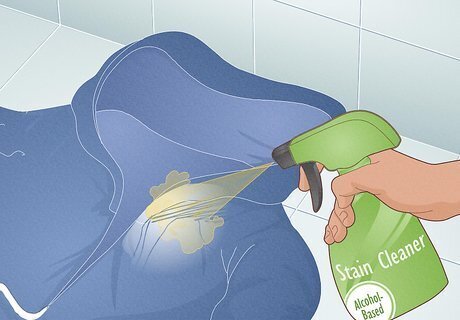
Spray the stain with an alcohol-based cleaner. Alcohol breaks down the paint’s bonds, so try rubbing alcohol or hairspray. If you don’t have an alcohol-based cleaner, acetone is another good option. Test by applying the cleaner to an inconspicuous area, then spray the affected area.

Blot the area with a rag. Once you’ve saturated the area with an alcohol-based cleaner, blot the area instead of scrubbing it. This will help prevent the stain from spreading. You should start to see some of the pigment transfer from the fabric to the cloth. The process may need to be repeated for thick layers of paint. If you’re dealing with carpet or upholstery, keep spraying and rubbing until you’ve removed the stain and dried the fabric.

Wash the item in the washing machine. To remove spray paint from clothes, check the garment’s label to ensure it’s machine wash safe. Then, apply a pre-wash stain remover, and run it through the washing machine on a cool setting. Don’t put paint-stained clothes in the wash with other items. This helps you avoid staining clean clothes. Be sure to use a cool setting, since warm or hot water will set the stain. If this doesn’t remove the stain, let the garment air dry, then repeat the spraying, blotting, and washing process. If repeating the process doesn’t work, take the garment to your professional dry cleaner.
Removing Spray Paint from Brick and Concrete

Apply paint stripper to the painted surface. Make sure the area is free of dirt and dust, then apply a small amount of the paint stripper to the affected surface. Let it sit for a few minutes and then wipe it off with a cloth. Repeat the process until the spray paint is completely removed. When working with paint stripper, wear gloves and work in a well-ventilated area, as it is flammable. Be sure to test the stripper in an inconspicuous area before applying it to the entire affected surface.

Use a graffiti remover. For large areas, a paint stripper might not be enough. Apply the remover to the affected area and let it sit for a few minutes. Then, scrub the area in a gentle circular motion. Blot the area with a clean towel, then rinse with warm water. Graffiti remover comes in many forms including pastes, aerosol cans, and liquid solutions. Instructions may differ depending on the type you use, so always read the instructions before applying the remover.
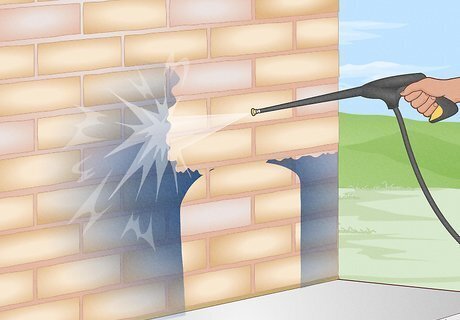
Use a pressure washer. Pressure wash with cold water at a setting less than 300 psi. Hold the nozzle about 1.5 to 2.5 feet (about 0.5 to 0.75 meters) from the surface, and wash from the bottom up to prevent dripping pigment from re-staining the surface. Wear work clothes, protective gloves, and goggles when pressure washing a wall.

Apply masonry cleaner to porous surfaces after stripping. Even after pressure washing, paint stripper can leave a residual shadow on stone or brick walls and other porous surfaces. Purchase masonry cleaner and dilute it at one part cleaner to six parts water. Apply the diluted solution to the surface, let it sit for one to two minutes, then pressure wash with cold water.
Removing Spray Paint from Glass

Use rubbing alcohol to loosen the spray paint. Apply the alcohol to a clean cloth and rub it over the glass until the spray paint starts to come off. Repeat the process until all the paint has been removed. You can also use the same method with white vinegar or acetone. Be careful with acetone, however, as it can damage some types of glass. Test it on a small area first.

Scrape the paint off with a razor blade. If rubbing alcohol doesn’t work, the stubborn paint may need to be scraped off. Hold the blade at a 45-degree angle to the glass and slowly begin peeling up the paint. Be careful not to cut yourself or scratch the glass.
Removing Spray Paint from Wood

Saturate the wood with paint remover or acetone. Some other options are soap and water or a goo remover like Goo Gone. Wait a few minutes to allow the solution to sink in.

Rub the spray paint away with a cloth. Go with the grain or rub in a circular motion. Test a small area first to see if the solution is working. If the paint begins to move or thin, this is a good sign that your solution will eventually remove all the paint. You may need to soak the paint in your solution a few times, but as long as you continue to see progress, this should eventually remove all of it.
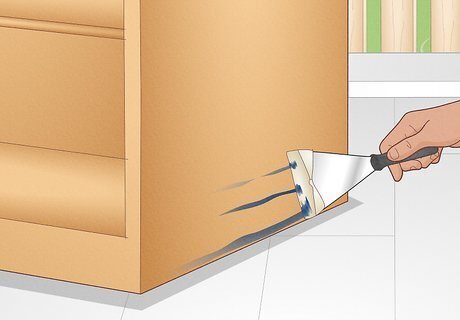
Use a paint scraper on tough areas. If the paint remover isn’t working, you may need to scrape the paint off. Try wrapping the scraper in a cloth to prevent it from scratching the wood beneath the spray paint.
Removing Spray Paint from Interior Walls

Use a paint thinner or TSP for latex wall paint. If your wall paint is water-based latex, apply a small amount of paint thinner to a clean cloth and rub it on the wall, testing a small, inconspicuous area first. If you’re using TSP or a TSP substitute, dilute it with water and rub the spray-painted area with a sponge. Always test solvents like these on a small area before applying it everywhere. This way, you’ll see if the solvent damages your wall or if you’re okay to move forward. A TSP substitute will be labeled as such on the bottle.

Use baking soda for oil-based wall paint. Baking soda is known for getting stubborn stains off of painted walls. Mix baking soda and water until it forms a paste, then apply the paste to the wall using a rag. Leave it on for 15 minutes, then wipe it off. Repeat as necessary. Be careful not to affect the wall paint’s finish.

If all else fails, scrape the paint off the wall. Scraping the spray paint off will likely take the wall paint with it and might scratch and damage the wall itself. If this happens, apply putty to cover the damage and then repaint the wall.
Removing Spray Paint from Metal
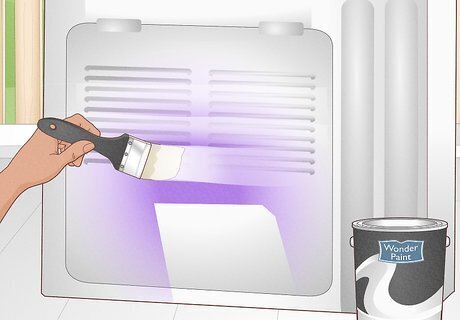
Apply a paint stripper or commercial cleaner. These come in a variety of forms such as aerosols, liquids, and pastes. Following the manufacturer's instructions, allow the paint stripper or cleaner to soak into the spray paint. Then, scrub the surface using an abrasive pad. Rinse the area with water, and repeat the process as needed.

Heat the metal with a hair dryer. If it is safe to do so, heating the metal helps loosen the spray paint. Once the paint is heated, use soap and water to remove the paint. Scrub any stubborn areas with a nylon brush.

Apply a baking soda paste. Combine baking soda and water to create the paste, then apply it to the affected area. Leave it on for about 15 minutes, then wipe it off. The spray paint should peel right off. If it doesn’t, repeat the process.
Removing Spray Paint from Cars

Try an automotive detail cleaner. You'll first want to try the least aggressive treatment when removing spray paint from your car. Start with a car exterior detail cleaner, which is available at your nearby automotive or home improvement store. Spray the cleaner onto the affected area and rub vigorously with a clean, dry cloth.

Apply carnauba wax to the spray-painted area. Squirt several generous dabs of wax onto a clean sponge. Rub the sponge over the spray paint using circular motions. The wax contains oils that should start breaking down the spray paint almost immediately. Carnauba wax is also called Brazil wax. Look for a product marked 100% carnauba or Brazil wax at your local home improvement or automotive store. Reapply more wax and use more pressure to remove stubborn patches of spray paint.

Buff out the wax with a clean microfiber towel. Wipe your towel across the waxed surface in quick, broad circular motions. This will remove excess wax and buff the freshly cleaned surface. If you still see any stray spots of spray paint, repeat the waxing and buffing process.

Use a rubbing compound. If you don't have success with carnauba wax, try applying an abrasive rubbing compound. Apply a small amount of car exterior rubbing compound to a cloth and lightly rub the affected area in small circles. Wax and buff the area once you've rubbed out the spray paint. Don't rush the process or try to rub in broad, hard circles, or you might damage your car's paint. Try testing the compound in an inconspicuous area first.
Removing Spray Paint from Plastic and Vinyl

Use a household remover like rubbing alcohol or acetone. Some other common household removers are vegetable oil or dish soap and warm water. Apply the solution to the affected area and let it sit for at least 15 minutes, then rub the area with a rag until the paint comes off.
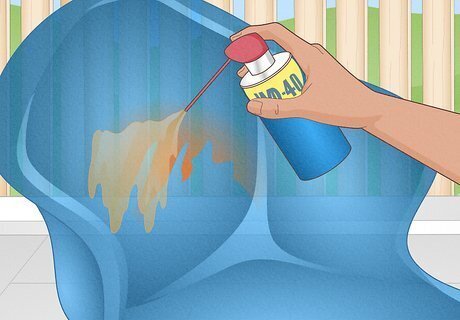
Try WD-40. If a household solution doesn’t work, try a commercial chemical like WD-40 or lacquer thinner. Apply the solution to a small area to ensure it doesn’t damage the plastic. If it doesn’t, use it on the rest of the surface to remove the spray paint. When working with chemicals like WD-40, always wear a respirator mask to avoid breathing in harsh chemicals.

For larger areas, try a pressure washer. If you’re trying to remove spray paint from the vinyl siding of a house, for example, scrub the area clean and then rinse the rest of the paint away with a pressure washer on a gentle setting.
Removing Spray Paint from Shoes

Spray the shoe with a household remover like detergent or acetone. Fill a spray bottle with a vinegar solution, acetone, or a cleaning detergent and spray the shoe generously. Allow the remover to soak for about 15 minutes to penetrate the stain, then use a scrubbing cloth to rub the spray paint off the shoes.
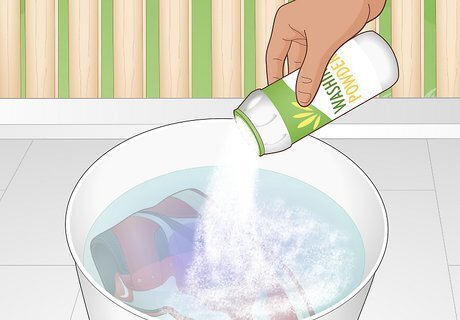
Use a washing powder. Soak your shoe in cold water for 30 minutes to loosen the paint, then scrub it with a scrubbing cloth. While your shoe is soaking, mix lukewarm water with a tablespoon of washing powder. Then, dip a cloth into the solution and dab it on the affected areas. Set the shoe aside and let the paint come off gradually. Be careful not to use too much washing powder, as it could ruin the fabric of your shoe. Don’t scrub or apply pressure to your shoe while the washing powder is soaking. The paint will come off naturally. Once the paint has come off, use a wet rag to remove any residue, then rinse with clean water. Dab your shoe with a towel to remove excess water, then set it aside in a well-ventilated room to dry.
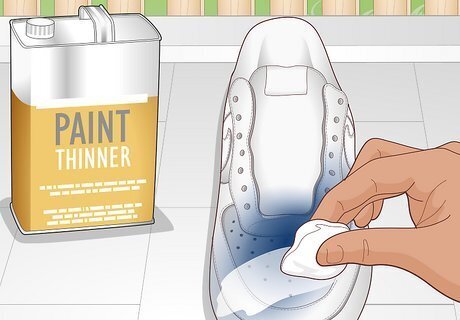
Use paint thinner for heavy stains. If the spray paint is dried out, test paint thinner by applying it to a small area on the stained shoe to make sure the fabric doesn’t react negatively to the chemicals. If there’s no negative reaction, apply the paint thinner to the shoe for instant stain removal. After applying the paint thinner, wash your shoes with clean water to remove the loose paint and the paint thinner. Set your shoes aside to dry. Always test paint thinner before applying it to the whole area. If you don’t, you risk ruining the shoe. This applies to other fabrics, as well.


















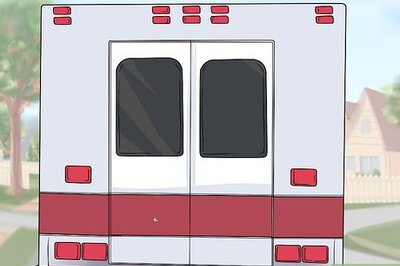
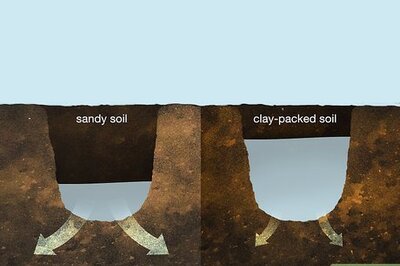
Comments
0 comment